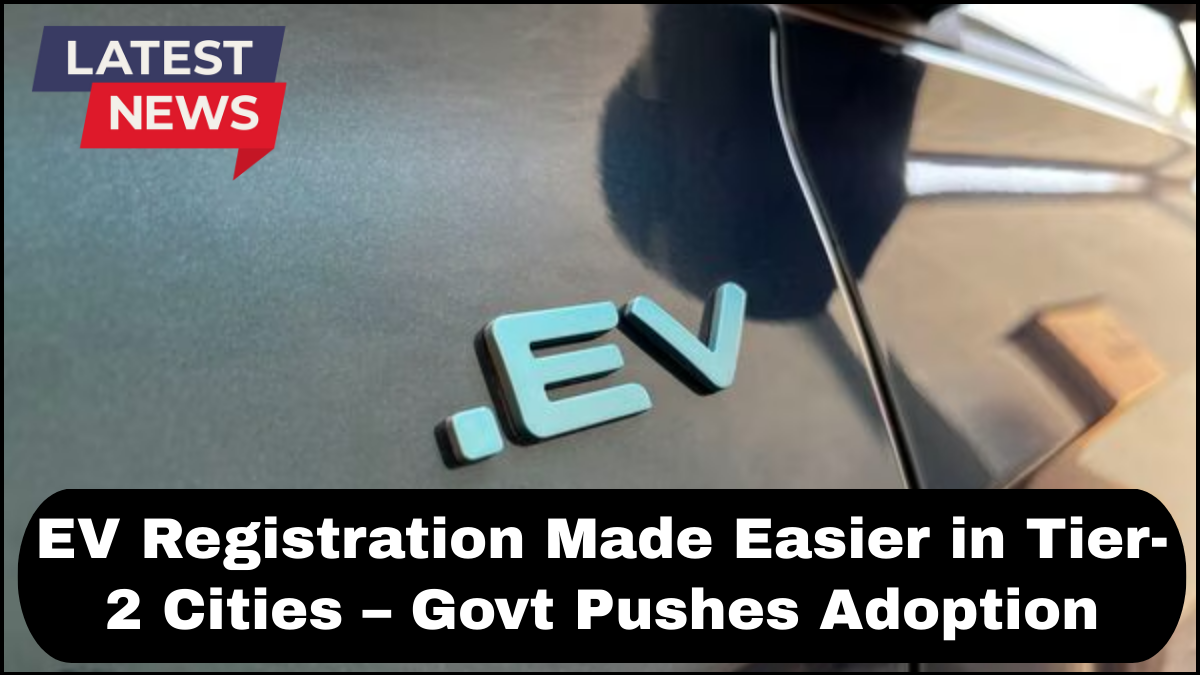Electric vehicles (EVs) are no longer a luxury for metro dwellers. With the Indian government now targeting Tier-2 cities for rapid EV penetration, the process of EV registration in Tier-2 cities has been significantly streamlined. Backed by policy shifts, digital integration, and local administrative support, the initiative aims to remove hurdles and accelerate adoption in smaller urban pockets.

Why Tier-2 Cities Are Crucial for India’s EV Growth
Tier-2 cities—like Bhopal, Surat, Lucknow, and Coimbatore—represent the next big frontier for EV expansion. These cities are experiencing a rise in income levels, increased environmental awareness, and worsening urban air quality. But until recently, cumbersome registration procedures, poor charging infrastructure, and limited access to financing had slowed EV uptake.
Now, the government is actively working to change that by removing friction from the most basic step—EV registration in Tier-2 cities.
Fast-Tracked Process: Cutting Down Bureaucracy
Traditionally, registering a vehicle in many smaller cities involved manual paperwork, long queues at Regional Transport Offices (RTOs), and delays in verification. The new framework introduces a fast-tracked process that reduces these bottlenecks through:
-
Online Portals for Registration: The Ministry of Road Transport and Highways (MoRTH) has integrated e-vehicle registration into the national Vahan portal. Tier-2 city RTOs are being upgraded to handle digital processing end-to-end, allowing owners to upload documents, pay fees, and receive digital RCs without stepping out of their homes.
-
Instant Approvals for Verified Manufacturers: Vehicles from recognized EV manufacturers are now eligible for expedited registration, as their data is pre-approved and synced with the national database.
-
Simplified Paperwork: EV buyers now need fewer documents, and the verification process has been automated in many states. Aadhaar-based authentication is being adopted widely to streamline identity verification.
State-Level Incentives Support the Push
Many state governments are offering targeted incentives to increase EV ownership in Tier-2 areas. For example:
-
Uttar Pradesh and Gujarat offer subsidies on electric two-wheelers and waive road tax for EVs.
-
Tamil Nadu’s new EV policy includes specific clauses that prioritize infrastructure and policy implementation in Tier-2 and Tier-3 cities.
-
Charging Infrastructure Development: As part of the FAME-II scheme, public charging stations are being rolled out across urban areas beyond Tier-1 cities.
These regional moves, coupled with easier EV registration in Tier-2 cities, are driving both demand and dealer confidence.
Local Governments Driving Change on the Ground
City administrations are also taking charge by organizing EV adoption drives, setting up local help centers for new EV buyers, and launching awareness campaigns. Public-private partnerships are being explored to train local RTO staff and develop service ecosystems around EVs—mechanics, battery swapping centers, mobile charging vans, etc.
The Role of Startups and Dealerships
The faster registration process is also encouraging more EV startups and dealerships to set up operations in Tier-2 cities. Brands like Ather Energy, Ola Electric, and Ampere are actively expanding into these markets, supported by favorable state policies and quicker registration turnaround times.
This, in turn, is improving consumer access to test drives, after-sales service, and financing options—all of which are critical for mass adoption.
The Road Ahead: Beyond Registration
While simplifying EV registration in Tier-2 cities is a big win, the journey doesn’t stop there. Stakeholders must also:
-
Scale up affordable charging infrastructure.
-
Ensure consistent power supply in satellite towns.
-
Train a skilled EV workforce.
-
Offer microloans and financing to lower-income buyers.
These efforts, when combined with a fast-tracked process for vehicle registration, can help smaller cities lead India’s electric mobility transformation.
Frequently Asked Questions (FAQs)
1. What has changed in EV registration in Tier-2 cities recently?
The government has streamlined the process by introducing online registration, automated document verification, and instant approvals for certain EVs. These changes aim to reduce wait times and eliminate bureaucratic hurdles.
2. Is the EV registration process fully online now?
In many Tier-2 cities, yes. The Vahan portal allows users to complete registration digitally. However, some manual steps may still be needed depending on the local RTO’s capabilities.
3. Are there any registration fee waivers for EVs in Tier-2 cities?
Yes. Several states offer exemptions on road tax, registration fees, or both as part of their EV policies.
4. How does the fast-tracked process benefit EV buyers in smaller cities?
It saves time, cuts down paperwork, reduces the need to visit RTOs in person, and makes the entire ownership journey smoother—especially for first-time buyers.
5. What other steps is the government taking to promote EVs in Tier-2 cities?
Apart from simplifying registration, the government is investing in charging infrastructure, offering subsidies, and supporting local businesses and startups that deal in EV sales and service.
click here to learn more